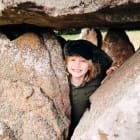
The story of Le Câtillon II, the largest hoard of Iron Age gold and silver coins, jewellery and ingots ever found in Western Europe
Jersey’s soil is rich with historical secrets. Every so often one of them is unearthed to huge public interest because those secrets are coin hoards, left behind by ancient people. There has been a long running treasure hunt across certain fields in Grouville, Jersey that has resulted in the discovery of Le Câtillon II, the largest hoard of Iron Age gold and silver coins, jewellery and ingots ever found in Western Europe. For over 30 years Reg Mead and Richard Miles, friends and fellow metal-detectorists, held on to a story told to Reg about a possible hoard of coins in a broken pottery jar, disturbed many years ago and re-buried. They obtained permission from the land owner and, between ploughings, mapped the field they were hoping might elicit a buzz or two from their machines. Eventually, on a cold January day in 2012, their metal detectors did indeed detect something interesting. And after much digging, 5 coins were found. They closed up the site and contacted Olga Finch Curator of Archaeology and Neil Mahrer, Conservator at Jersey Heritage. It was the right thing to do – yet curiosity to keep digging must have almost broken their resolve.
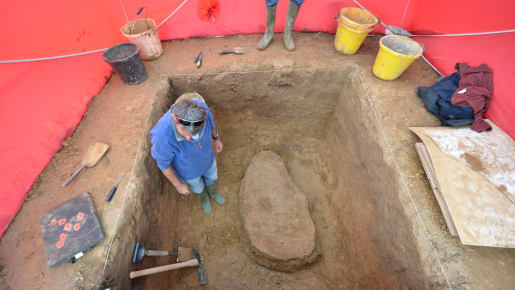
Coin hoard excavation
At first everyone assumed that what had been found was the bottom half of that long-ago broken pot. They all thought the dig would last a day at most. 5 days later they were still there, carefully uncovering a mass of precious metal objects and earth that weighed about a ton. “As soon as the top was exposed”, explains Neil, “we could see the coins and we knew it was a coin hoard. Up until that time the biggest Celtic coin hoard that had been found – which also came from Jersey – was before the war and that was about 12,000 coins. So, by the end of the first day we knew we had a really big hoard. And then it rapidly became apparent that it was bigger than any other.”
Once the hoard was taken out of the ground in one piece. Neil then drew up a report and a conservation plan, and Jersey Heritage got funding to work on it for three years. Neil, who specialises in archaeological conservation, explains the fairly rough and ready way the hoard was made: ‘What they basically did is dig a bathtub-sized hole in the ground, about three feet deep and just poured all the coins, jewellery and ingots in.’ That is an amazing image to us today, as it seems both a reckless and risky thing to do with such a valuable treasure. Taking the hoard apart and recording the position of each piece in it was an unusual opportunity from an archaeological point of view. Most finds are, understandably, dug out and separated as soon as they are discovered.
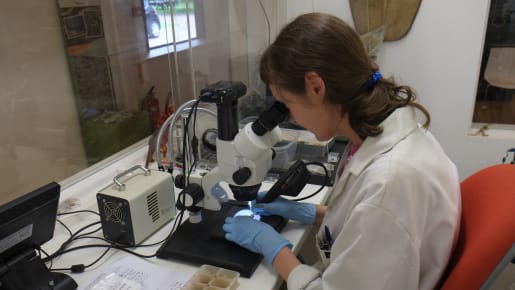
Researching the hoard
What has changed since he started working in conservation, Neil explains, is the way archaeological finds are worked on. “20 or 30 years ago, one would have found a gold or silver object and simply cleaned it straight away, to restore it to its original appearance. Now we know that there’s all sorts of information that can be gained from the corrosion and the surface detail. So, we’re much more cautious about what we actually do with the material that we find.” A hoard of this size would once have been brought up in small bucket loads as no one had ever lifted a coin hoard of this size intact before. “When we finally did arrange for permissions and funding, we were able to do what was essentially a complete excavation on the actual object itself.”
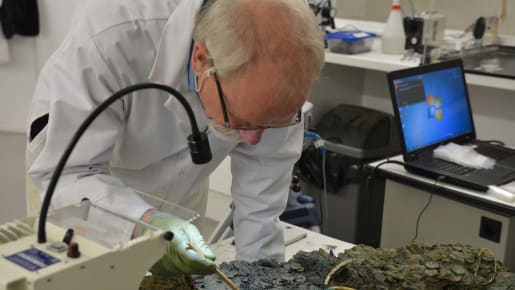
Removing corrosion from the torque
Using a device called a six axis metrology arm, fitted with scanning laser and point probe heads the team at Jersey Heritage were able to produce both laser scans of the hoard’s surface and 3D maps of all the coin and object positions within the hoard. They numbered every single one of the 69,000 coins, recording their position within the hoard. The jewellery found amid the coins included gold torques, silver bracelets, rings and glass beads. One of the most intriguing pieces of information these new recording methods revealed was that the team now think that this was actually two different hoards poured into one hole on the same day. “We think the first hoard poured into the hole was made up of older, better coins – by which I mean they contained more silver – and most of the gold jewelry, glass beads and ingots. A second hoard of later, poorer quality coins was then poured over the top. That is something that we would never have known if all the coins had been brought out without recording their positions.”
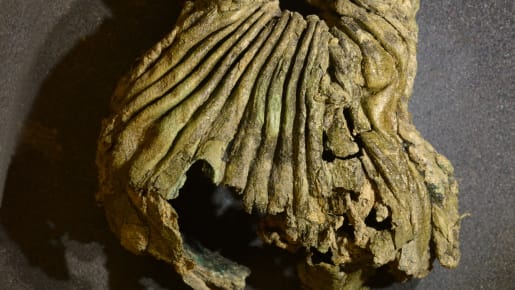
A purse found within the hoard
After all this time – over 10 years – and a lot of legal to-ing and fro-ing, Jersey government has just agreed with the crown to purchase the hoard. It is now officially in the care of Jersey Heritage. In many ways, this is where Neil’s work begins, certainly where it continues. “The next lot of research will be split between research on the hoard contents, the coins, gold torques and objects and also, on the actual environments that hoard came from, to give us context. Because at the moment we know very little about why the hoard was there – we’ll be doing geophysical research around the area to find if it was a village, temple or a hill fort. We’re just beginning to plan that second phase of research now.”
Neil and the Jersey Heritage will be working with specialist universities and organisations to facilitate the new phase of investigations into the hoard. They are starting it from a very strong position, too. Neil quietly admits: “As of now, this is probably the best excavated and conserved hoard that there’s been, certainly in Britain. And we are right at the forefront of this sort of research, really.”
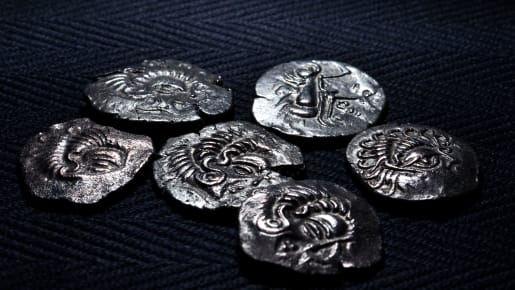
Coriosolitae coins
Places to Visit
Dolmen de Faldouët
A free-to-access dolmen built around 6,000 years ago to align with the rising sun on the spring and autumn equinox.
Places to Visit
La Hougue Bie
A peaceful and ancient site where you can visit one of the oldest buildings in the world.







